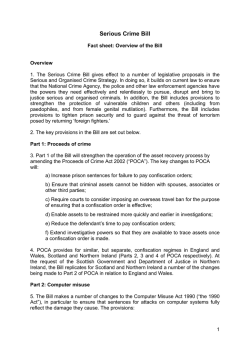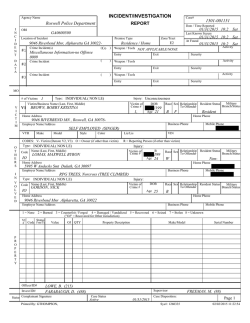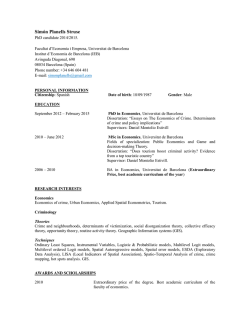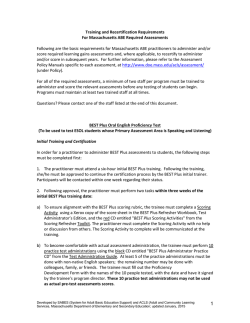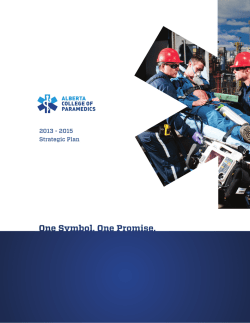
2014-078 - Eurojust
STRATEGIC SEMINAR TOWARDS GREATER COOPERATION IN FREEZING AND CONFISCATION OF THE PROCEEDS OF CRIME: A PRACTITIONERS’ APPROACH The Hague, 11 December 2014 REPORT Introduction The Strategic Seminar “Towards Greater Cooperation in Freezing and Confiscation of the Proceeds of Crime: A Practitioners’ Approach”, jointly organised by Eurojust and the Italian Presidency of the EU, took place on 11 December 2014. The Strategic Seminar took place in combination with the 8th Meeting of the Consultative Forum of Prosecutors General and Directors of Public Prosecutions of the Member States of the European Union (Consultative Forum) that was convened on 12 December 2014 by the Prosecutor General of Italy with the support of Eurojust. Participants of Member States, EU institutions and Eurojust attended both events. The goal of the Seminar was to bring practitioners together in order to identify difficulties in mutual recognition in asset recovery associated with the current legal framework. On this basis, legal and practical ways to maximise judicial cooperation in this area were identified, in particular in the three workshops devoted to specific topics. The conclusions of the three workshops were presented during the Consultative Forum meeting on 12 December and served as the basis for further discussion by the Forum members. The Forum also discussed and reached conclusions on some of the main challenges and best practices in the investigation and prosecution of cases of trafficking in human beings and illegal immigrant smuggling involving migration flows through the sea, and the state of play of negotiations on the draft Eurojust and European Public Prosecutor’s Office (EPPO) Regulations. The Strategic Seminar on 11 December was chaired by Francisco Jiménez-Villarejo (VicePresident of Eurojust and National Member for Spain) and opened by Antonio Mura (Head of Department for Justice Affairs, Italian Ministry of Justice). Session I: How to tackle difficulties in cross-border asset recovery cases This Session was chaired by Francisco Jiménez-Villarejo (Vice-President of Eurojust and National Member for Spain). The following keynote speakers intervened during the first session. FINAL 17.04.2015 1 of 9 ___________________________________________________________________________ Svetlana Klouckova (Director of International Affairs Department, Czech Republic Supreme Public Prosecutor’s Office) gave a presentation on challenges and best practices in asset tracing, freezing and confiscation from a practitioner’s point of view. In this context she underlined the crucial importance of ensuring close cooperation amongst all authorities involved, including police, prosecutors, Asset Recovery Offices (AROs) and Financial Investigation Units (FIUs), at national and international level. The important role FIUs can play in financial investigations was further highlighted with reference to the experience of the Czech Republic in this respect. As FIUs have different status and powers in different Member States, the European Commission and Eurojust were called upon to organise meetings with practitioners to study possible ways to overcome difficulties they face in their work. While welcoming the novelties introduced by Directive 2014/42/EU of 3 April 2014 on the freezing and confiscation of instrumentalities and proceeds of crime, she pointed out that some Member States might have difficulties in implementing some of its provisions. In this context, she advocated the preparation of guidelines for practitioners summing up good practices from Member States who that have been dealing effectively with civil recovery and called upon Eurojust to take an active role in this exercise. Leif Görts (National Member for Sweden and Chair of Financial and Economic Crime Team) presented an overview of the legal and practical difficulties faced by national authorities as identified in Eurojust’s asset recovery cases. He indicated that not all AROs have access to relevant databases and that expertise in the form of financial investigators or “forensic accountants” would enhance the Member States’ capacity to access relevant financial information. Moreover, he stressed how the lack of central bank registers and the unharmonised national provisions on bank secrecy can hamper efforts to identify assets. He also explained that the difference in both substantive and procedural rules between Member States is a major obstacle in the identification, tracing and recovery of proceeds of crime. In this context, difficulties related to the principle of dual criminality and the requests for execution of a confiscation order arising from a Member State with a non-conviction based confiscation regime by a Member State which requires links with criminal proceedings also hamper mutual recognition in this area. Eurojust’s role to help resolve some of the above mentioned difficulties was emphasised. Francesco Lo Voi (Eurojust National Member for Italy) presented the main features of the Italian legal system which provides for three main forms of confiscation: mandatory conviction-based confiscation; non-conviction based or “preventive” confiscation; and confiscation applied to legal persons. Not only direct and indirect proceeds from crime can be confiscated: the Italian system also allows for the confiscation of other property of equivalent value to the proceeds of crime (value confiscation). Non-conviction based confiscation is a particularly powerful tool against mafia-type criminal organisations: when links with mafia-type criminal groups can be proved (e.g. by prior convictions), preventive confiscation applies vis-à-vis suspects who cannot prove the lawful origin of their assets (reverse of the onus probandi). However, differences between legal systems can hamper cross-border asset recovery. The crucial role played by Eurojust in this field was illustrated with a concrete case resulting in the execution of an Italian non-conviction based seizure order by the Dutch authorities. R EPORT EUROJUST S TRATEGIC S EMINAR “Towards Greater Cooperation in Freezing and Confiscation of the Proceeds of Crime: a Practitioners’ Approach ” (THE H AGUE , 11 DECEMBER 2014) FINAL 17.04.2015 2 of 9 ___________________________________________________________________________ Session II: A critical evaluation of instruments adopted at EU level in the area of freezing and confiscation This Session was chaired by Antonio Mura (Head of Department for Justice Affairs, Italian Ministry of Justice). The following keynote speakers intervened during the second session. Olivier Tell (DG Justice, Head of Procedural Criminal Law Unit, European Commission) presented the key findings of the Comparative Study on the Implementation of Mutual Recognition Orders to Freeze and Confiscate Criminal Assets in the EU, yet to be released. The Study highlights that overall too few criminal assets are seized across the EU in cross-border cases. Among the reasons for that, the Study indicates: 1) an under use of freezing and confiscation orders in the Member States, 2) unwillingness by competent national authorities to pursue assets located abroad, 3) Member States’ legal systems might not be able to implement mutual recognition requests of confiscation orders from countries operating under very different rules and procedures. In referring to a potential dichotomy between civil proceeding based confiscations and criminal proceeding based confiscations, the Commission indicated that in reality the two systems might be closer than expected. Overall, the Study emphasises that whatever the system (in rem or in personam confiscation), it is essential that fundamental rights are respected, that effective judicial review is in place together with the ability to challenge any type of decision setting forth confiscation. The Commission further recalled that the existing Framework Decisions on mutual recognition of freezing and confiscation orders remain unimplemented or poorly implemented, and reminded that these measures now fall within the jurisdiction of the European Court of Justice with the Commission having a role of “Guardian of the Treaty”. Finally, the Commission is considering carefully how to respond to the Joint Statement issued by the European Parliament and the Council (Council doc. 7329/1/14 REV1 ADD1) calling for action in the field of mutual recognition of confiscation orders and is examining the potential to improve the framework at EU level. Nicola Selvaggi (Professor, Universita’ di Reggio Calabria, Italy) presented a critical view of the current EU legal framework in the field of asset recovery. He stated that freezing and confiscation of the proceeds of crime is nowadays considered as one of the most effective means of deterring and combatting organised crime. Moreover, the reuse of confiscated property for public interest or social purposes enhances the public confidence in the criminal justice system. However, the existing Framework Decisions on mutual recognition of freezing and confiscation orders remain unimplemented by some Member States, and the overall amount recovered from crime in the EU remains modest. The newly adopted Directive on freezing and confiscation enhances the harmonisation of national rules by amending existing provisions on extended confiscation and introducing new provisions on non-conviction based confiscation (in limited circumstances) and third party confiscation to improve the mutual recognition of freezing and confiscation orders. The new Directive respects the principle of proportionality and fundamental rights. R EPORT EUROJUST S TRATEGIC S EMINAR “Towards Greater Cooperation in Freezing and Confiscation of the Proceeds of Crime: a Practitioners’ Approach ” (THE H AGUE , 11 DECEMBER 2014) FINAL 17.04.2015 3 of 9 ___________________________________________________________________________ Angélique Hardy (Policy advisor to MEP Monica Macovei, European Parliament) gave an overview of the main features of the Directive on freezing and confiscation and mentioned future legislative actions to be taken at EU level. Amongst the most relevant novelties, she mentioned the provisions on non-conviction based confiscation, extended confiscation and third party confiscation. She also referred to the specific safeguards and judicial remedies to protect the fundamental rights of individuals affected by confiscation orders and the rights of victims. She stressed that all these provisions, by introducing a certain degree of harmonisation in national laws, will facilitate mutual recognition. She highlighted, however, that this will only be possible if all Member States transpose and implement the Directive in a similar manner. Reference was made to the Commission’s intention to organise meetings in 2015 to facilitate this exercise. Furthermore, she welcomed the intention of the ARO Platform to establish subgroups on asset management and on social re-use of confiscated property. She also underlined the importance of complementing existing confiscation systems with non-conviction based confiscation schemes and she welcomed the Joint Statement by the European Parliament and the Council (Council doc. 7329/1/14 REV1 ADD1) and the intention of the European Parliament to move forward and advocate for more EU-legislation on civil recovery. In the afternoon, three workshops were held in parallel on specific issues relating to the main challenges encountered in judicial cooperation in relation to freezing, confiscating and recovering proceeds of crime. The conclusions of the workshops can be summarised as follows. Workshop 1: Asset tracing, freezing and confiscation: challenges in mutual recognition and execution Chair: Ladislav Hamran (Vice-President of Eurojust and National Member for the Slovak Republic, Eurojust) The discussions within the workshop followed a pragmatic approach and focused on practical problems encountered by practitioners. They touched upon the three main phases of a crossborder asset recovery case, i.e. tracing, freezing and confiscation of assets. For ease of reference, the workshop conclusions are grouped below under two main areas: (i) tracing of assets; and (ii) freezing and confiscation of assets. (i) With regard to the tracing of assets, workshop participants concluded that: Due to the complexity of the matter and of transnational crime in general, practitioners face practical difficulties when identifying assets in cross-border asset recovery cases. It is therefore crucial to ensure appropriate dedicated training programmes for prosecutors in this area and not only to law enforcement authorities. There is a need for specialised prosecutors as well as good cooperation with FIUs. The use of practical tools that can facilitate the identification of assets should be enhanced. For instance, the lack of central bank registers and public registers for companies in several Member States can hamper and delay cooperation. Moreover, when such databases already exist, it would be useful for practitioners to know where they are available. R EPORT EUROJUST S TRATEGIC S EMINAR “Towards Greater Cooperation in Freezing and Confiscation of the Proceeds of Crime: a Practitioners’ Approach ” (THE H AGUE , 11 DECEMBER 2014) FINAL 17.04.2015 4 of 9 ___________________________________________________________________________ Eurojust should collect practical information on asset tracing and make it available to practitioners to facilitate their daily work. The existence of reliable centralised registers does not always solve the problems: often criminals do not register goods and banking operations under their names (hidden beneficiaries) and prosecutors face difficulties in identifying those criminals, linking their activities to the assets and finding suitable evidence to prove that link. AROs’ support is relatively limited in this regard. A certain harmonisation of structures and powers of the FIUs would be useful: quick information from FIUs is important because quick cooperation is needed. Drafting and translating complex and detailed letters of request takes time. Too much formalisation should be avoided and mutual trust should serve to execute a request more speedily. Eurojust has proven to be a swift and reliable channel of communication and its role should be exploited further. In general, mutual recognition instruments and other legal instruments (such as the 2001 Protocol to the 2000 Convention on Mutual Assistance in Criminal Matters) aimed at facilitating the gathering of banking information are still underused by practitioners. ii) With regard to the freezing and confiscation of assets, workshop participants concluded that: The differences between national legislations result in an enhanced need for exchange of information and communication among national authorities. As a consequence, requests for additional information cause delays and difficulties in cross-border cases. Different problems also stem from the different legal bases that apply which include EU, Council of Europe and UN instruments. A certain level of harmonisation at EU level is needed with a view to cooperating more efficiently in this complex area. There is a need for manuals and clear guidelines providing prosecutors with explanations of laws (including national and EU case law), forms and check-lists on what to do in practice. It is important for practitioners to be able to know the state of play of the implementation of the various EU instruments in the Member States and the way in which these instruments have been implemented. The European Judicial Network (EJN) website already provides such information and work is ongoing with the Commission to further develop this comprehensive overview. Considering the complexity of the legal framework, the codification or consolidation of the existing EU instruments for freezing and confiscation in one standalone “texte unique” from a mutual recognition point of view would be helpful for practitioners (although it would not solve all problems). The examples of the European Arrest Warrant (EAW) in the “extradition area” and the European Investigation Order (EIO) in the “evidence area” could be followed. In order to be more efficient, a multidisciplinary approach involving FIUs, AROs, police and customs authorities working alongside prosecutors, should be promoted in crossborder cases of freezing and confiscation, as well as the support of Eurojust. Practical difficulties have been identified with regard to returning the money seized in cross-border cases to victims. Eurojust could help facilitate the communication and find possible solutions in these cases. Furthermore, to effectively protect bona fide third R EPORT EUROJUST S TRATEGIC S EMINAR “Towards Greater Cooperation in Freezing and Confiscation of the Proceeds of Crime: a Practitioners’ Approach ” (THE H AGUE , 11 DECEMBER 2014) FINAL 17.04.2015 5 of 9 ___________________________________________________________________________ parties, it was suggested to modify the Schengen Information System (SIS) as far as the tracing of stolen items is concerned. Eurojust should be closer to practitioners, provide them with more practical information and ensure dissemination of its findings. For instance, the outcome of “College topics” could be made available on the Eurojust Extranet. In addition, Eurojust is encouraged to promote and facilitate cooperation with relevant third countries (e.g. China), also by organising regional conferences. Workshop 2 Alternatives to conviction-based confiscation: ensuring that crime does not pay Chair: Francis Cassidy (National Member for Ireland, Eurojust) Discussions mainly touched upon (i) the nature of non-conviction based confiscation; and (ii) whether it would be possible to design a common civil asset forfeiture regime encompassing the necessary procedural rights which could not be challenged by a potential encroachment upon fundamental rights and that could be subject to the principle of mutual recognition. i) With regard to the nature of non-conviction based confiscation, workshop participants concluded that: Non-conviction based confiscation is not more intrusive than extended confiscation. Practitioners should not be misled by terminology: disputes regarding definitions should be avoided. There is a certain degree of confusion among practitioners about this confiscation scheme and what it exactly entails. One should not be prone to “labelling”; on the contrary, it would be wiser to look into the merit of a confiscation order to assess what is truly at stake. There is a need to find ways to harmonise the different complex rules regarding confiscation that are applied at national level. At this stage, a practical approach to executing non-conviction based orders rather than enacting new legislation would be preferred. Such an approach, however, would not allow for the application of the principle of mutual recognition, as it would necessitate a merit-based analysis of any confiscation order issued, for instance, in the course of a civil proceeding, based on the balance of probabilities that assets derive from criminal conduct. Reference was made to the execution of EAWs, where no merit based assessment is required: the aim would be to achieve, in the future, a similar regime for confiscation orders, even those issued without a previous conviction. Consideration was given to the fact that any kind of confiscation order is issued by a judicial authority in accordance with due process and hence it should not matter whether this occurred in the course of criminal or civil procedures. Consideration should be given to the standard of proof which is needed when a link with organised crime activities is believed to be found. Reference was made to the need to take into consideration “unexplained wealth” that could potentially trigger a reverse R EPORT EUROJUST S TRATEGIC S EMINAR “Towards Greater Cooperation in Freezing and Confiscation of the Proceeds of Crime: a Practitioners’ Approach ” (THE H AGUE , 11 DECEMBER 2014) FINAL 17.04.2015 6 of 9 ___________________________________________________________________________ of the onus probandi. In any event, the burden of proof that the assets are the proceeds of crime is extremely high, which would explain why in a number of Member States confiscation can only be undertaken after a conviction. ii) With regard to a common forfeiture asset regime, workshop participants concluded that: The European Court of Human Rights jurisprudence confirmed that non-conviction based confiscation does not, in principle, contravene fundamental rights such as the right to peaceful enjoyment of one’s property and the right to a fair hearing. Confiscation should not only be conceived as a punishment but also as a preventive measure. Only when it is considered a punishment, a criminal procedure is needed to issue a confiscation order. A simplification of available EU instruments is needed, which could possibly lead to a further level of harmonisation in confiscation matters. Only after harmonisation is achieved will the principle of mutual recognition be applied. To foster the process, participants suggested that it would be useful to collect best practices, especially regarding how some Member States have dealt with non-conviction based confiscation and how a solution was found. Further research in this field would be welcome. Workshop 3 Legal and judicial challenges in asset management and disposal, sharing and repatriation of confiscated assets from a practitioner’s point of view Chair: Filippo Spiezia (Deputy National Antimafia Prosecutor, National Antimafia Directorate, Italy) The discussions within the workshop touched upon three main areas: (i) the adequacy of the existing legal framework on the management and disposal of frozen and confiscated assets; (ii) the challenges and best practices to ensure that assets are managed adequately; and (iii) best practices in the sharing and repatriation of confiscated assets. i) With regard to the adequacy of the existing legal framework on the management and disposal of frozen and confiscated assets, workshop participants concluded that: The management of frozen and confiscated property is a crucial phase of the asset recovery process which ought not to be overlooked by practitioners and the legislator to ensure that efforts made for tracing, freezing and confiscating assets are not in vain. The existing EU legal instruments in this area are sufficient but there is a need for proper implementation at national level. The return of confiscated assets to victims and the possibility to allow confiscated assets to be used for social purposes need to be R EPORT EUROJUST S TRATEGIC S EMINAR “Towards Greater Cooperation in Freezing and Confiscation of the Proceeds of Crime: a Practitioners’ Approach ” (THE H AGUE , 11 DECEMBER 2014) FINAL 17.04.2015 7 of 9 ___________________________________________________________________________ prioritised to send a clear message to the victims and the communities that crime does not pay. The Italian anti-Mafia legislation which provides for detailed procedures for the management and disposal of assets is a possible model to be studied, in particular: (i) the detailed rules for the management and final destination of assets based on their nature (immovable assets, companies, money, etc.); (ii) the time limits for deciding on the final destination of confiscated property; (iii) third party rights, including bona fide ones; and (iv) the measures taken in order to avoid that confiscated assets are sold back to the criminal groups. The appointment of liaison officers for asset recovery, as well as direct contacts and meetings between the judicial authorities from different jurisdictions are best practices to prevent and solve differences between national legislation and practices in the area of management and disposal of confiscated assets and to allow for increased judicial cooperation. A wider distribution of the ARO’s compilation of national laws on the management and disposal of assets was also proposed. ii) With regard to the challenges and best practices to ensure that assets are managed adequately, workshop participants concluded that: Property frozen with a view to possible subsequent confiscation should be managed adequately in order not to lose its economic value. The difficulties in managing certain assets, such as bitcoins or company shares were emphasised. Some Member States have adopted the strategy of converting non-cash assets to cash as soon as they are seized in order to preserve and maximise their value. Member States should take relevant measures, for example by establishing centralised Asset Management Offices, specialised offices or equivalent mechanisms. Specific training and awareness-raising activities would be desirable to enhance specialisation amongst practitioners. The importance of promoting a multidisciplinary approach and the interaction amongst different stakeholders involved in the management and disposal of seized and confiscated assets was highlighted. iii) With regard to the best practices in the sharing and repatriation of confiscated assets, workshop participants concluded that: It is very important for judicial authorities to discuss the sharing and repatriation of confiscated assets as soon as assets which are located abroad need to be frozen in view of their confiscation. On a case-by-case basis, Eurojust can play an important role in clarifying legal requirements and practices in the Member States for the disposal, sharing and repatriation of assets. R EPORT EUROJUST S TRATEGIC S EMINAR “Towards Greater Cooperation in Freezing and Confiscation of the Proceeds of Crime: a Practitioners’ Approach ” (THE H AGUE , 11 DECEMBER 2014) FINAL 17.04.2015 8 of 9 ___________________________________________________________________________ Concluding agreements on sharing and repatriation of assets was regarded as a best practice. Where appropriate in specific cases, Eurojust could be asked to facilitate such agreements between judicial authorities. Following the presentations by the rapporteurs of the workshops, some final remarks were made by Antonio Mura (Head of Department for Justice Affairs, Italian Ministry of Justice) and Ladislav Hamran (Vice-President of Eurojust and National Member for the Slovak Republic, Eurojust). Antonio Mura (Head of Department for Justice Affairs, Italian Ministry of Justice) thanked the participants for sharing their experience in the area of asset recovery. He noted that the EU’s goal to deprive criminals of the proceeds of their illicit activities and limit the infiltration of these proceeds into the legal economy must remain on the agenda for further consideration. He summarised the main ideas that arose as a result of the Strategic Seminar. With regard to the obstacles hampering mutual recognition in this area, practical ways to maximise judicial cooperation through existing legal instruments as well as further legislative action were suggested. Participants concluded that further harmonisation of substantial criminal law and freezing and confiscation regimes would enhance mutual recognition and facilitate judicial cooperation in this area. Moreover, while ensuring respect for fundamental rights, further rules on the confiscation of property deriving from activities of a criminal nature, also in the absence of a conviction, ought to be considered in order to strengthen the existing EU legal framework. Finally, the importance of enhancing cooperation between Member States once the proceeds of crime have been frozen, seized or confiscated was emphasised. Ladislav Hamran (Vice-President of Eurojust and National Member for the Slovak Republic), noted that organised crime activities are profit driven and that, accordingly, confiscation and asset recovery is an appropriate tool to fight serious crime. Mr Hamran stated that the number of asset recovery cases registered at Eurojust has significantly increased in the last years. Eurojust has the potential to actively assist judicial authorities in this area, for example by facilitating the execution of requests for judicial cooperation, including instruments giving effect to the principle of mutual recognition, by enabling the coordination of investigations or by solving practical problems caused by different legal systems. In so doing, Eurojust identifies the main judicial challenges faced by practitioners and presents best practices on how to improve the use of mutual recognition instruments in this area. Hence, he encouraged Member States to continue making use of Eurojust. ________________ R EPORT EUROJUST S TRATEGIC S EMINAR “Towards Greater Cooperation in Freezing and Confiscation of the Proceeds of Crime: a Practitioners’ Approach ” (THE H AGUE , 11 DECEMBER 2014) FINAL 17.04.2015 9 of 9
© Copyright 2025
